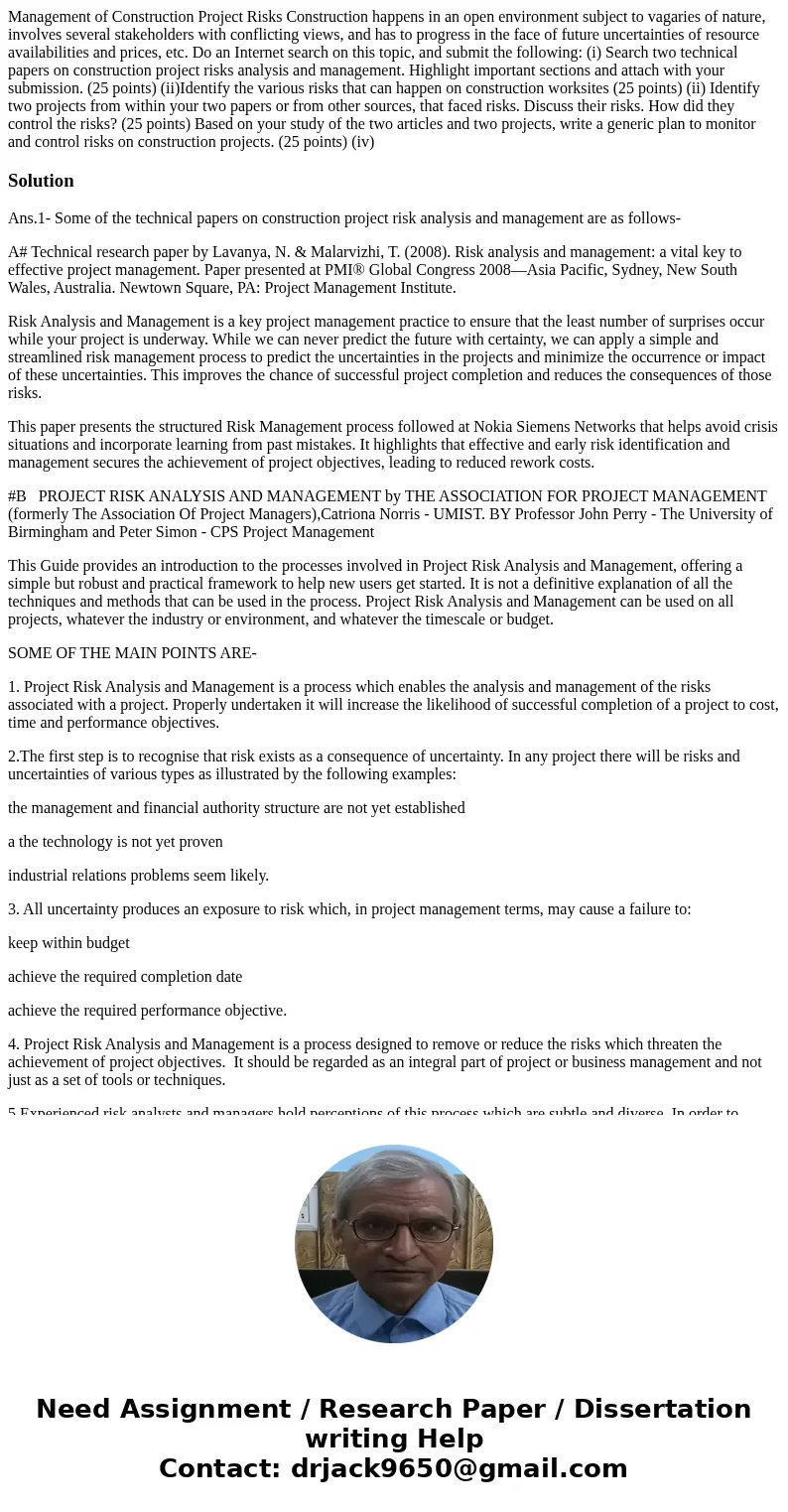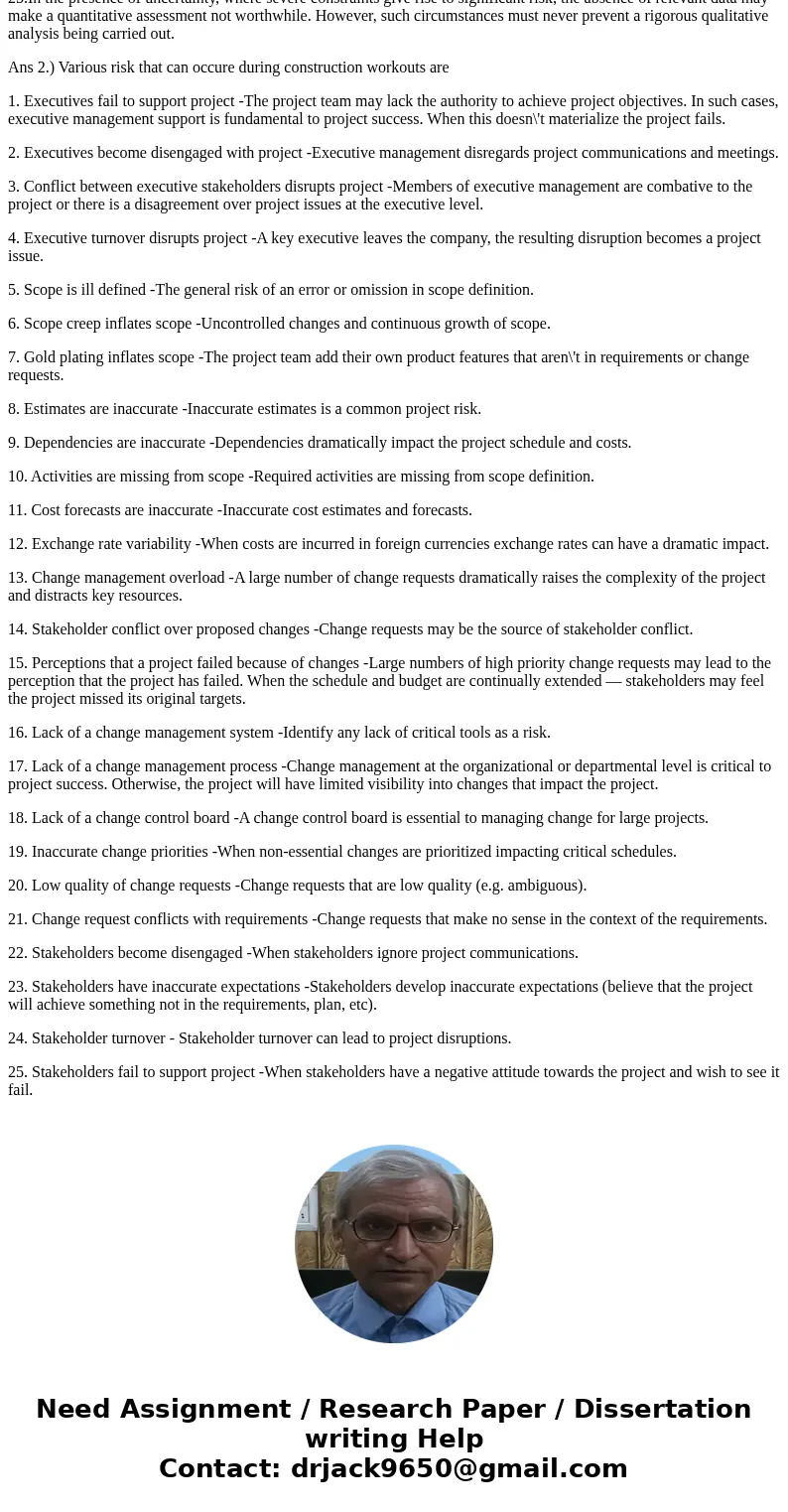Management of Construction Project Risks Construction happen
Solution
Ans.1- Some of the technical papers on construction project risk analysis and management are as follows-
A# Technical research paper by Lavanya, N. & Malarvizhi, T. (2008). Risk analysis and management: a vital key to effective project management. Paper presented at PMI® Global Congress 2008—Asia Pacific, Sydney, New South Wales, Australia. Newtown Square, PA: Project Management Institute.
Risk Analysis and Management is a key project management practice to ensure that the least number of surprises occur while your project is underway. While we can never predict the future with certainty, we can apply a simple and streamlined risk management process to predict the uncertainties in the projects and minimize the occurrence or impact of these uncertainties. This improves the chance of successful project completion and reduces the consequences of those risks.
This paper presents the structured Risk Management process followed at Nokia Siemens Networks that helps avoid crisis situations and incorporate learning from past mistakes. It highlights that effective and early risk identification and management secures the achievement of project objectives, leading to reduced rework costs.
#B PROJECT RISK ANALYSIS AND MANAGEMENT by THE ASSOCIATION FOR PROJECT MANAGEMENT (formerly The Association Of Project Managers),Catriona Norris - UMIST. BY Professor John Perry - The University of Birmingham and Peter Simon - CPS Project Management
This Guide provides an introduction to the processes involved in Project Risk Analysis and Management, offering a simple but robust and practical framework to help new users get started. It is not a definitive explanation of all the techniques and methods that can be used in the process. Project Risk Analysis and Management can be used on all projects, whatever the industry or environment, and whatever the timescale or budget.
SOME OF THE MAIN POINTS ARE-
1. Project Risk Analysis and Management is a process which enables the analysis and management of the risks associated with a project. Properly undertaken it will increase the likelihood of successful completion of a project to cost, time and performance objectives.
2.The first step is to recognise that risk exists as a consequence of uncertainty. In any project there will be risks and uncertainties of various types as illustrated by the following examples:
the management and financial authority structure are not yet established
a the technology is not yet proven
industrial relations problems seem likely.
3. All uncertainty produces an exposure to risk which, in project management terms, may cause a failure to:
keep within budget
achieve the required completion date
achieve the required performance objective.
4. Project Risk Analysis and Management is a process designed to remove or reduce the risks which threaten the achievement of project objectives. It should be regarded as an integral part of project or business management and not just as a set of tools or techniques.
5.Experienced risk analysts and managers hold perceptions of this process which are subtle and diverse. In order to simplify the process this Guide divides the overall process into two constituents or stages:
Risk Analysis
Risk Management.
6. Qualitative Analysis allows the main risk sources or factors to be identified.A sound aim is to identify the key risks, perhaps between five and ten, for each project (or part-project on large projects) which are then analysed and managed in more detail.
7.A Quantitative Analysis often involves more sophisticated techniques, usually requiring computer software. To some people this is the most formal aspect of the whole process requiring:
measurement of uncertainty in cost and time estimates
probabilistic combination of individual uncertainties.
8.Risk Management may start during the qualitative analysis phase as the need to respond to risks may be urgent and the solution fairly obvious.
9. Risk Management can involve:
identifying preventive measures to avoid a risk or to reduce its effect
establishing contingency plans to deal with risks if they should occur
initiating further investigations to reduce uncertainty through better information
considering risk transfer to insurers
considering risk allocation in contracts
setting contingencies in cost estimates, float in programmes and tolerances or \'space\' in performance specifications.
10. There are many reasons for using Project Risk Analysis and Management, but the main reason is that it can provide significant benefits far in excess of the cost of performing it.
11.The benefits gained from using Project Risk Analysis and Management techniques serve not only the project but also other parties such as the organisation and its customers.
12.an increased understanding of the project, which in turn leads to the formulation of more realistic plans, in terms of both cost estimates and timescales.
13.An increased understanding of the risks in a project and their possible impact, which can lead to the minimisation of risks for a party and/or the allocation of risks to the party best able to handle them
14.An understanding of how risks in a project can lead to the use of a more suitable type of contract
15.An independent view of the project risks which can help to justify decisions and enable more efficient and effective management of the risks
16.Benifits gives a knowledge of the risks in a project which allows assessment of contingencies that actually reflect the risks and which also tends to discourage the acceptance of financially unsound projects
17.Who benefits from its use?
an organisation and its senior management for whom a knowledge of the risks attached to proposed projects is important when considering the sanction of capital expenditure and capital budgets
clients, both internal and external, as they are more likely to get what they want, when they want it and for a cost they can afford
project managers who want to improve the quality of their work i.e. they want to bring their projects in to cost, on time and to the required performance.
18.The costs of using Project Risk Analysis and Management techniques vary according to the scope of the work and the commitment to the process. Below are some example costs, time- scales and resource requirements for carrying outthe process.
19. The cost of using the process can be as little as the cost of one or two days of a person\'s time up to a maximum of 5-10% of the management costs of the project, even this higher cost, as a percentage of the total project cost, is relatively small. It can be argued that the cost incurred is an investment if risks are identified during the process that may otherwise have remained unidentified until it was too late to react.
20.The time taken to carry out a risk analysis is partially dependent upon the availability of information. A detailed cost and time risk analysis usually requires anywhere from one to three months depending upon the scale and complexity of the project and the extent of planning and cost preparation already carried out. However, as indicated above, a useful analysis can take as little as one or two days.
21.The minimum resource requirement is obviously just one person within a organisation with experience of using Project Risk Analysis and Management techniques. However, if expertise does not exist within the organisation it can be readily acquired from outside consultants. It is likely that once Project Risk Analysis and Management has been introduced to an organisation, in-house expertise will develop rapidly.
22.There are a few circumstances when it is particularly advisable to use Project Risk Analysis and Management techniques, these are:
when there are specific targets that must be met
when there is an unexpected new development in a project
at points of change in the life-cycle of a project.
23. Project Risk Analysis and Management is a continuous process that can be started at almost any stage in the life-cycle of a project and can be continued until the costs of using it are greater than the potential benefits to be gained. As time progresses, the effectiveness of using Project Risk Analysis and Management tends to diminish, therefore it is most beneficial to use it in the earlier stages of project.
24.It can be used on any type of project, but it is more beneficial for some projects than others. Some examples of projects which would benefit from Project Risk Analysis and Management are:
innovative, new technology projects
projects requiring large capital outlay or investment
fast-track projects
projects which interrupt crucial revenue streams
unusual agreements (legal, insurance or contractual)
25.In the presence of uncertainty, where severe constraints give rise to significant risk, the absence of relevant data may make a quantitative assessment not worthwhile. However, such circumstances must never prevent a rigorous qualitative analysis being carried out.
Ans 2.) Various risk that can occure during construction workouts are
1. Executives fail to support project -The project team may lack the authority to achieve project objectives. In such cases, executive management support is fundamental to project success. When this doesn\'t materialize the project fails.
2. Executives become disengaged with project -Executive management disregards project communications and meetings.
3. Conflict between executive stakeholders disrupts project -Members of executive management are combative to the project or there is a disagreement over project issues at the executive level.
4. Executive turnover disrupts project -A key executive leaves the company, the resulting disruption becomes a project issue.
5. Scope is ill defined -The general risk of an error or omission in scope definition.
6. Scope creep inflates scope -Uncontrolled changes and continuous growth of scope.
7. Gold plating inflates scope -The project team add their own product features that aren\'t in requirements or change requests.
8. Estimates are inaccurate -Inaccurate estimates is a common project risk.
9. Dependencies are inaccurate -Dependencies dramatically impact the project schedule and costs.
10. Activities are missing from scope -Required activities are missing from scope definition.
11. Cost forecasts are inaccurate -Inaccurate cost estimates and forecasts.
12. Exchange rate variability -When costs are incurred in foreign currencies exchange rates can have a dramatic impact.
13. Change management overload -A large number of change requests dramatically raises the complexity of the project and distracts key resources.
14. Stakeholder conflict over proposed changes -Change requests may be the source of stakeholder conflict.
15. Perceptions that a project failed because of changes -Large numbers of high priority change requests may lead to the perception that the project has failed. When the schedule and budget are continually extended — stakeholders may feel the project missed its original targets.
16. Lack of a change management system -Identify any lack of critical tools as a risk.
17. Lack of a change management process -Change management at the organizational or departmental level is critical to project success. Otherwise, the project will have limited visibility into changes that impact the project.
18. Lack of a change control board -A change control board is essential to managing change for large projects.
19. Inaccurate change priorities -When non-essential changes are prioritized impacting critical schedules.
20. Low quality of change requests -Change requests that are low quality (e.g. ambiguous).
21. Change request conflicts with requirements -Change requests that make no sense in the context of the requirements.
22. Stakeholders become disengaged -When stakeholders ignore project communications.
23. Stakeholders have inaccurate expectations -Stakeholders develop inaccurate expectations (believe that the project will achieve something not in the requirements, plan, etc).
24. Stakeholder turnover - Stakeholder turnover can lead to project disruptions.
25. Stakeholders fail to support project -When stakeholders have a negative attitude towards the project and wish to see it fail.




 Homework Sourse
Homework Sourse